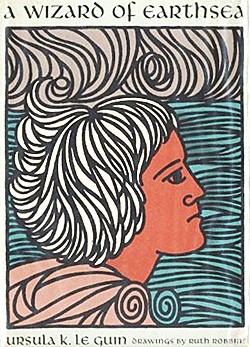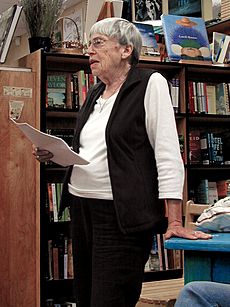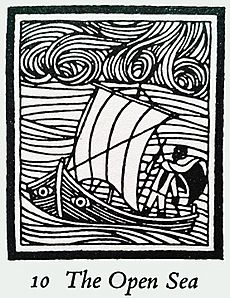A Wizard of Earthsea facts for kids
 |
|
| Author | Ursula K. Le Guin |
|---|---|
| Illustrator | Ruth Robbins |
| Country | United States |
| Language | English |
| Series | The Earthsea Cycle |
| Genre | Fantasy novel |
| Publisher | Parnassus Press |
|
Publication date
|
1968 |
| Media type | Print (Hardcover & Paperback) |
| Pages | 205 |
| ISBN | ISBN 0-395-27653-5 |
| OCLC | 1210 |
| Followed by | The Tombs of Atuan |
A Wizard of Earthsea is a classic fantasy novel. It was written by American author Ursula K. Le Guin. The book was first published in 1968. Many people consider it a very important book for young readers and for the fantasy genre.
The story takes place in a world of many islands called Earthsea. It follows a young wizard named Ged. He is born on the island of Gont. Ged shows amazing magical power even as a boy. He later joins a special school for wizards. However, his proud nature causes trouble. During a magic contest, Ged's spell goes wrong. It accidentally releases a scary shadow creature. This creature attacks him. The book then follows Ged's journey as he tries to escape and defeat this creature.
A Wizard of Earthsea is often called a "coming-of-age" story. This means it shows Ged growing up and learning important lessons. He learns how to handle his great power. He also learns to accept difficult things, like death. The book also has ideas from Taoism. This is about a natural balance in the world of Earthsea. Wizards are supposed to protect this balance. The story also teaches that words and names have power. They can change the world and its balance.
The book received many good reviews. People first liked it as a children's book. Later, adults also enjoyed it. It won the Boston Globe–Horn Book Award in 1969. It also won the Lewis Carroll Shelf Award in 1979. Famous author Margaret Atwood said it was one of the main sources for fantasy literature.
Ursula K. Le Guin wrote five more books in the Earthsea Cycle series. These books continue Ged's story. They are The Tombs of Atuan (1971), The Farthest Shore (1972), Tehanu (1990), The Other Wind (2001), and Tales from Earthsea (2001).
Many writers have praised the series. George Slusser called it a "work of high style and imagination." Amanda Craig said A Wizard of Earthsea was "the most thrilling, wise, and beautiful children's novel ever."
Contents
How the Book Was Created
The ideas for the Earthsea world first appeared in two short stories. These were "The Rule of Names" (1964) and "The Word of Unbinding" (1964). Both stories were published in a magazine called Fantastic. Later, these stories were put into Le Guin's collection The Wind's Twelve Quarters (1975).
These early short stories introduced the world of Earthsea. They also showed important ideas, like how magic works in this world.
Exploring the World of Earthsea
The Setting: A World of Islands
"Only in silence the word,
only in dark the light,
only in dying life:
bright the hawk's flight
on the empty sky."
Earthsea is an archipelago, which means it's a group of many islands. In the story's history, a very old god or hero named Segoy created these islands. The world has both humans and dragons. Some humans are powerful sorcerers or wizards.
The world of Earthsea is based on a delicate balance. Most people know about this balance. But in each of the first three books, someone upsets it. Earthsea is a pre-industrial world. This means it doesn't have modern factories or machines. It has many different cultures across its islands.
Most characters in the story are from the Hardic peoples. They have dark skin. They live on most of the islands. Some eastern islands are home to the white-skinned Kargish people. They think the Hardic folk are evil sorcerers. The Hardic people, in turn, see the Kargish as wild people. Dragons live in the far western parts of the islands.
The Story: Ged's Journey
The novel begins with a young boy named Duny. His nickname is "Sparrowhawk." He is born on the island of Gont. His aunt discovers his great natural power. She teaches him the little magic she knows.
One day, his village is attacked by Kargish raiders. Duny uses magic to create a fog. This hides the village and helps the people fight off the Kargs. A powerful wizard named Ogion hears about this. He takes Duny as his student. Ogion gives him his true name—Ged.
Ogion tries to teach Ged about "equilibrium." This is the idea that magic can upset the natural order if used wrongly. But Ged is impatient. He tries to impress a girl by looking through Ogion's spell books. He accidentally summons a strange shadow creature. Ogion has to banish it. Ogion senses Ged's eagerness. He sends Ged to a famous wizard school on the island of Roke.
At the school, Ged's skills impress even the teachers. He becomes friends with an older student named Vetch. But he often stays away from other students. Another student, Jasper, acts superior to Ged. This makes Ged's proud nature angry. After Jasper teases Ged at a feast, Ged challenges him to a magic duel.
Ged tries a powerful spell to raise a spirit. But the spell goes wrong. Instead, it releases the shadow creature again. The creature attacks Ged and scars his face. The head wizard, Archmage Nemmerle, drives the shadow away. But he loses his own life doing so.
Ged spends many months healing. Then he goes back to his studies. The new Archmage, Gensher, says the shadow is an ancient evil. It wants to control Ged. He warns Ged that the creature has no name. Ged eventually gets his wizard's staff. He goes to live in the Ninety Isles. There, he protects poor villagers from dragons. These dragons have taken over the nearby island of Pendor.
But Ged finds the shadow is still chasing him. He knows he cannot fight both threats at once. So, he sails to Pendor. He risks his life by guessing the adult dragon's true name. He is right! The dragon offers to tell him the shadow's name. But Ged instead makes the dragon promise. The dragon and its children will never threaten the islands again.
The shadow continues to chase Ged. He flees to Osskil. He has heard of a magical stone there called the Terrenon. The shadow attacks him. He barely escapes into the Court of Terrenon. Serret, the lady of the castle, shows him the stone. She tells Ged to speak to it. She claims it can give him endless knowledge and power. Ged realizes the stone holds one of the Old Powers. These are ancient, powerful, and evil beings. Ged refuses to speak to it. He runs away. The stone's helpers chase him. But Ged changes into a fast falcon and escapes.
Ged flies back to Ogion on Gont. Unlike Gensher, Ogion believes all creatures have a name. He tells Ged to face the shadow. Ogion is right; when Ged looks for the shadow, it runs from him. Ged chases it in a small sailboat. The shadow lures him into a fog. His boat crashes on a reef.
Ged recovers with the help of an old couple. They have been stuck on a small island since they were children. The woman gives Ged part of a broken bracelet as a gift. Ged fixes his boat. He continues chasing the creature into the East Reach. On the island of Iffish, he meets his friend Vetch. Vetch insists on joining him. They travel far east, beyond all known lands. Finally, they find the shadow. Ged calls it by his own name. The shadow merges with him. Ged joyfully tells Vetch he is healed and whole.
Artwork in the Book
The first edition of the book came out in 1968. It had illustrations by Ruth Robbins. The cover was in color. Inside, there was a map of the Earthsea islands. Also, each chapter had a black-and-white drawing by Robbins. These drawings looked a bit like woodcut images.
The pictures showed things from each chapter. For example, the first picture showed the island of Gont. The drawing for "The Dragon of Pendor" showed a flying dragon. The image you see here shows Ged sailing in his boat Lookfar. This picture was used in Chapter 10, "The Open Sea." In that chapter, Ged and Vetch travel east to face the shadow creature.
Other Versions of the Story
The first chapter of the book was made shorter and illustrated. It was printed by World Book in a children's encyclopedia called Childcraft in 1989. The book has also been made into audio versions.
BBC Radio created a radio play in 1996. It was narrated by Judi Dench. In 2015, they made a six-part series. This series adapted all the Earthsea novels. It was broadcast on Radio 4 Extra. In 2011, Robert Inglis recorded the full, unshortened book.
Two screen versions of the story have also been made. A mini-series called Legend of Earthsea aired in 2004. It was shown on the Sci Fi Channel. This series was only very loosely based on A Wizard of Earthsea and The Tombs of Atuan. Ursula K. Le Guin was very unhappy with it. She said the series changed Ged's character. In the book, Ged has red-brown skin. But the show cast a "petulant white kid" as Ged. She felt they "whitewashed Earthsea." This meant they ignored her choice to write about a non-white character. She said this choice was very important to her book. Other reviews agreed. They said Legend of Earthsea "totally missed the point" of Le Guin's novels. They felt it removed the books' beauty and added boring clichés.
Studio Ghibli released a film version in 2006. It was called Tales from Earthsea. This movie also loosely combined parts of the first, third, and fourth books. It created a new story.
See also
 In Spanish: Un mago de Terramar para niños
In Spanish: Un mago de Terramar para niños



